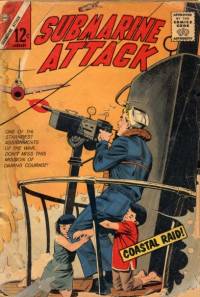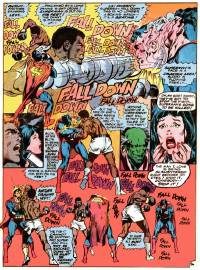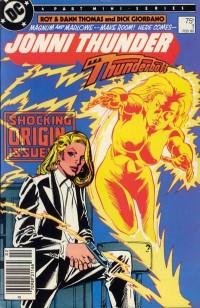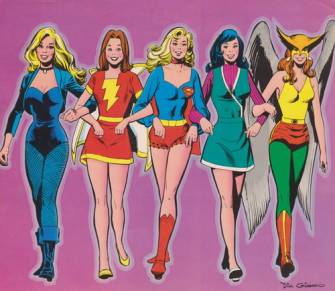
March 28, 2010
 Richard Joseph Giordano, 1932-2010
Richard Joseph Giordano, 1932-2010

 By Tom Spurgeon
Dick Giordano
By Tom Spurgeon
Dick Giordano, a longtime pencil artist and inker as well as a key comics industry figure at
Charlton and
DC Comics,
passed away on Saturday, March 27. He had reportedly been battling leukemia, a fight which was recently noted as having made a potential turn for the worse. Giordano was 77 years old.
Giordano was born in Manhattan and like many of his eventual cartooning peers made use of New York's focused high school system to receive the bulk of his early artistic training. He majored in illustration and advertising art at the
High School Of Industrial Art. Once out of school, Giordano went immediately to work at the
S.M. Iger Studio, where he was put to work inking backgrounds on titles such as
Fiction House's
Sheena. This sobering introduction to the field of commercial comics would be his home for the next nine months.
By 1952, Giordano was working freelance and publishing a variety of work through Charlton. Thus began one of two great professional relationships of his long career. Giordano was one of several artists hired when Charlton brought their nascent comics production capabilities in-house in 1951, under
Al Fago as editor. Giordano's peer group with the company, which was already building a reputation as a publisher willing to follow youth buying trends into every corner of the comics market, included
Sam Glanzman,
Sal Trapani,
Joe Gill, and
Rocke Mastroserio. Giordano would later marry Trapani's sister, Marie.

Giordano seized the Charlton opportunity with both hands, performing a number of jobs across various genres and of every kind, big and small, that were assembled into comics at the time. Among the titles he worked on in the early 1950s were
Lawbreakers,
Racket Squad In Action,
The Thing,
Space Adventures,
Hot Rods and Racing Cars and
True Life Secrets. One can see two elements of distinction in Giordano's initial burst of work with Charlton. Unlike some of his peers who were either paired with an inker or pencil artist or even hired one of their own to increase productivity, many of Giordano's early credits had the artist performing both tasks. Giordano also began to do a number of covers, perhaps far ahead of what most artists with his productivity level on inside features might have done. Giordano's early covers frequently focused on a figure, either in action or repose, with backgrounds or scene-setting details falling away. Giordano would develop into one of mainstream comics' more passionate proponents of comics art as a storytelling form rather than an illustrative opportunity, even in still moments like the ones covers generally provided.
Giordano's career at Charlton tends to be marked by a slow rise through the ranks to become managing editor. While true, that progression, like that of American comics, was more fractured than first appears. Giordano began as a freelancer, but in 1955 went on staff at Charlton to keep his assignments. The comics industry of the late 1950s continued to be savaged by distribution trouble and general decline in a readership spending more time staring at television that reached into the relatively and insular Charlton. Although his work there continued unabated, as the '50s turned over, Giordano also picked up romance work from Marvel, a few gigs for the
Treasure Chest title, a variety of jobs from Dell and even a comic or two for British publisher Alan Class. Giordano seems to have negotiated this dark period better than most, purchasing his first home with Marie in 1959.

Charlton laid down the foundations for a brief run of superhero comics that proved popular with hardcore fans in the very early 1960s, with brief runs on a Captain Atom and Blue Beetle character -- neither of which included Giordano, but as a creator making editorial in-roads he was certainly increasingly familiar with the company's line-wide strategies. With Marvel's success attracting press by the mid-1960s, and after the now-dissatisfied Marvel cornerstone and longtime Charlton artist Steve Ditko returning more fully to that company's fold in 1966, Giordano was able to spearhead the Charlton Action Hero Line that included Captain Atom, a re-jiggered Blue Beetle,
The Peacemaker,
Peter Cannon... Thunderbolt,
The Question and the character Judomaster.
Not only did that bunch of titles make an impression on fans -- perhaps creatively so ahead of their bottom-line sales success -- and not only would Giordano's involvement presage a use of similar characters a couple of decades later with
Watchmen, the move drove notice to Giordano from mainstream comics giant DC Comics. The hiring of Giordano into DC's editorial was one of several moves by newly named Editorial Director Carmine Infantino in 1967. Giordano fit both of Infantino's apparent qualifications for such a position: he was a working artist with an artist's appreciation for comics storytelling and effective cover image-making, and he had direct experience editing, particularly working with new talent.
Giordano is credited with involvement in two of DC's most highly regarded series of the period:
Bat Lash, an easy-going western in the vein of Warner's immensely popular
Maverick television series and offering readers a vaguely insouciant counter-culture feel, and a run of "Deadman" stories in
Strange Adventures, one of comics' best attempts ever to use the superhero's uncanny ability to hold multiple genres to its chest by attaching horror elements to an otherwise standard costume and origin template. Burgeoning comics superstar Neal Adams drew the Deadman comics; Adams would prove to be a crucial creative and business partner to Giordano over the next decade and beyond. Comics like
Bat Lash and the Deadman run were crucial to DC in that they allowed the company to partially staunch the bleeding in terms of cultural cool that was the result of Marvel's 1960s success, and pointed towards a creative direction for the company to pursue in order to stay relevant with a certain taste-making, hardcore readership in what seemed at the time like a potentially dying industry.
Giordano left DC in the very early '70s to work with Neal Adams at Continuity, where they packaged a variety of comics for a number of purposes, including special projects with both of Giordano's previous biggest clients: DC and Charlton. In 1977 he would start his own company, "Dik-Art," to serve the same kind of clients only with greater autonomy and control. Although this kind of break with traditional publisher/creator relationships was rare enough in comics history that as a business move each stands out on Giordano's long resume, there were two outcomes in terms of art during that period that may have had a greater effect on the cartoonist's overall legacy.

The first was that Giordano became the best of Adams collaborators in terms of inking his work. Giordano's fealty to figure drawing and ability to dissipate just that tiniest bit of over-the-top energy that Adams brought to some of this freelance work made that partnership work much better in terms of comics and storytelling of both the single-image and narrative flow kind than either Hall of Famer would enjoy teamed with other artists. He worked with Adams on memorable runs of
Batman and
Green Lantern/Green Arrow, and also worked with him on 1978's iconic
Superman Vs. Muhammad Ali, a comic with a deserved pop-culture pedigree that's grown in stature for the relative high quality of the comics art and storytelling contained therein. Giordano also inked Ross Andru on
Superman Vs. The Amazing Spider-Man, a popular 1976 novelty book that showed just how much the two companies house styles had grown close together.

The second was that almost as soon as Giordano walked in the front door of the New York City comics publisher he began working on covers for DC, starting with romance titles but soon branching out into their more popular titles, particularly those starring Batman. Giordano proved to be a pro's pro in that arena, adapting to various trends and visual signatures with startling alacrity. Story was front and center. A typical Giordano cover might feature a staged scene reminiscent if not exactly loyal to a scene in the comic, but the general handsomeness of the cartoonist's art at this stage in his career afforded whatever was drawn with a simple authority that was appropriate to DC's longtime standing within the industry. He would stay one of the iconic cover artists of that late Silver Age period, doing his part to define DC's overall look until the 1980s and fractured influences across multiple genres began to take hold.
In 1980, DC Publisher
Jenette Kahn brought Giordano back into DC's fold. He rapidly ascended from a position editing the various Batman books to managing editor (1981) to Vice President/Executive Editor (1983), the position he held until his departure. When Giordano was brought on, DC had yet to find its footing in a comics marketplace focused less on traditional strengths like brand strength and newsstand sales and more on devoted fans spread out across generations and a Direct Market that allowed publishers to reach those fans with much less risk than had been the case decades earlier. Giordano focused on the comics DC was publishing, initiating what he later called -- casually -- a five-year plan (noting that he may have been a year or two behind), bringing on new talent, matching them to projects best designed to flatter the various, important DC properties. Like many creators in the 1980s, Giordano's pay was based on bottom-line sales. Unlike most creators, his bonuses included revenue from licensing. He settled into a precarious balancing act: revitalizing the DC icons while protecting each one's traditional function within the publishing line.
Giordano worked within the strictures of a leadership team comprised of himself, Kahn and
Paul Levitz (
Joe Orlando was sometimes included by Giordano as a highly-important fourth cog.) Giordano described the 1980s DC triumvirate in a 1988 interview with
Gary Groth:
Actually, the three of us work pretty well together as a team. I'm kind of pleased with it. Paul's title is executive vice-president and essentially he's in charge of, if you want to get down to the simple facts, marketing, to some degree, and the money end of it. He's the one who tells me when I've over-spent my budget, or when I've spent my money foolishly. But he has no input direct into the contents of the magazines. He's the on that will let me know if we've done something that is legally wrong. Jenette, as publisher, is responsible essentially for making the decisions on what material we publish and for guiding me in what kind of material we want to publish for a given year. My basic responsibility is long-range planning in terms of what properties we're going to put on. I decided most of the properties that are going to be published simply by reading a humongous amount of proposals, by looking at work from artist and so on and so forth."
Giordano's description of the editorial team with whom he worked was about 20 people total, seven or eight that reported directly to him, and that in the end he felt responsible for everything between the covers of every DC comic of that period.

Among successes with which he's at least partially if not primarily credited is the reorganization/re-launch of popular characters through event series and special publishing events, the company's major, line-wide
Crisis On Infinite Earths crossover that married the development of these properties to an actual storyline, and the grouping of a small bunch of successful horror-tinged titles into a full-blown imprint called
Vertigo. Even some of his initiatives that didn't quite come to successful fruition, like a proposed children's line and a graphic novel series, involved measure the company would eventually pursue. Many of the younger artists that Giordano had shepherded through jobs at Charlton, DC (the first time around) and Continuity were among the industry's leading talents. He edited DC's groundbreaking
The Dark Knight series with
Denny O'Neil, but perhaps just as importantly had his hand in a variety of creative efforts that kept the sometimes-staid company creatively vital during that period, for instance green-lighting
Bob Fleming and
Trevor Von Eeden's bizarre and still slightly ahead of its time series
Thriller, or working with Neal Pozner on the first of many modern attempts to resuscitate
Aquaman, or green-lighting two
Nathaniel Dusk series featuring art from an absolutely in-his-prime
Gene Colan. Giordano continued to be a mentor and touchstone to emerging artists, especially inkers who looked up to that aspect of his career. He continued to contribute artistically, for instance working on
John Byrne's revamp of Superman (
The Man Of Steel) and the
Crisis interiors.
Giordano was essential throughout the development of the DC's hugely success and highly-regarded
Watchmen book, being present during the initial recruitment of writer
Alan Moore into the American company's fold during an early talent-searching trip to the UK, through the acquisition by DC of the Charlton superhero characters as his former publisher began to crash and burn, to suggesting to Moore that he use original characters on the book to greater creative effect.
Giordano's public profile with comics fans grew in the 1980s through a monthly column called "Meanwhile..." that promoted company news through its publications. Unlike such efforts in EC and most famously
Marvel Comics, there was very little tomfoolery inherent in Giordano's pieces, almost nothing or an arch nudge-nudge, wink-wink tone. They were written in a relatively sober, absolutely friendly voice, like a friend of your father's you particularly liked and didn't mind sitting down to listen to. As a pipeline into at least some aspects of working in what still felt like a closed industry miles and miles away from most fans, the "Meanwhile..." columns may have led many in the rising creative class to feel they had the same kind of tutorial relationship as some of the artists with whom Giordano more directly worked.
The 1980s were a hotbed of creators' rights discussions and decisions made on both sides of the divide between creator and publisher. Part of Giordano's legacy as an industry figures is his central role in DC's labeling controversy during this period. He provided his own, eloquent disquisition into his decision-making on the matter and the beliefs fueling them in an interview with Gary Groth in
The Comics Journal #119 (January 1988). Denying the persistent accusation that DC had looked into labeling their books due to outside pressure from sources critical of some content like prominent Direct Market retailer
Buddy Saunders, Giordano unpacked a view where in-company labeling would act as a replacement tool for an increasingly creaky and arbitrarily applied
Comics Code. He also, perhaps to greater controversy, suggested that while DC's decisions might cost them relationships with creators such as
Frank Miller and Alan Moore, and that he and others would miss them personally and as revenue-generators, the company would manage to move forward with or without them. "I'm not happy with the situation," he told Groth, "but if you're asking does it hurt from a standpoint of publishing comics in terms of sales, not as much as you might think."

Giordano left his position at DC at the midpoint of 1993, closely linked to the passing of his wife Marie due to complications from cancer and partly due to an increasing hearing loss that would come to have a greater and greater effect with just how the comics veteran managed to negotiate his way through the industry. His position was retired with him, and his duties were spread out amongst a surging in numbers editorial staff. Giordano remained a consultant with the company, working on areas of general expertise such new talent development. He remained an active artist, for example providing art to DC's 1994
Modesty Blaise prose adaptation, and standing in for short inking stints on various DC series up until a few short years ago, even as more and more of DC's archival work was bringing back to the stands various projects from the middle and early days of Giordano's long career. In 2002, Giordano was part of the abortive
Future Comics effort, working with his friend
Bob Layton. In more recent years, Giordano served on the board of the charity
The Hero Initiative. A positively bubbly semi-autobiography written with Michael Eury called
Changing Comics, One Day at a Time was released in 2003 from Twomorrows.
Giordano was one of several working professionals of his generation that made time to teach comics, working at a variety of institutions including Parsons, The Joe Kubert School, the Comic Art Workshop and Syracuse University.
Giordano received several awards for his work. They include the Alley Award for Best Editor in 1969 and the Shazam Award for Best Inker in 1970, 1971, 1973 and 1974. He received an Inkpot from Comic-Con International in 1981. He was named to the Eagle Awards' Roll of Honour in 1986 and shared a Harvey Award in 1997 for his role in editing the original series of what was that year's Best Domestic Reprint Project. He is on this year's Eisner Award Hall Of Fame nominees list.
 posted 10:00 am PST
posted 10:00 am PST |
Permalink
Daily Blog Archives
November 2019
October 2019
September 2019
August 2019
July 2019
Full Archives


